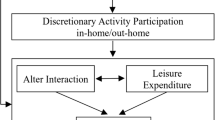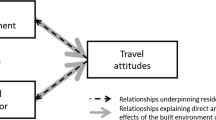Abstract
The purpose of this study is to determine the causal factors that influence travel behavior. In particular, the joint relationships between trips, activities and activity durations are researched by examining the effects of personal and household attributes. In order to meet this objective, the total, direct and indirect effects of individual attributes on travel behavior are estimated using structural models. The statistical assumption and the interpretations of coefficients in classical causal analysis are similar to those in linear regression models. Specifically, the direct effects, as estimated coefficients, are only offered and interpreted. However, in travel behavior that results from complicated relationships among trips, activities and individual attributes, the indirect effects among factors related to travel behavior cannot be disregarded. The indirect effects through other intervening factors, in addition to the direct effects, may cause the total effect of specified factors on travel behavior. If only the direct effect is considered for analysis, the causal relationships among factors may not be able to be adequately understood. The advantage of using structural models is that they are able to estimate, in addition to direct structural effects, the indirect effects through other intervening factors. The study also assumes that Saturday travel behavior has an effect on Sunday travel behavior. The subdivided indirect effects of the personal and household attributes on trip generation, activity frequency, and activity durations are empirically analyzed in detail.
Similar content being viewed by others
References
Adler, T. and Ben-Akiva, M. (1979). “A theoretical and empirical model of trip chaining behavior.” Transportation Research B, Vol. 13, No. 4, pp. 243–257.
Bhat, C. R., Frusti, T., Zhao, H., Schonfelder, S. and Axhausen, K. W. (2004). “Intershopping duration: an analysis using multiweek data.” Transportation Research B, Vol. 38, No. 1, pp. 39–60.
Byrne, B. M. (1989). A primer of LISREL, basic applications and programming for confirmatory factor analytic models, Springer-Verlag, New York Berlin Heidelberg.
Golob, T. F. (1989). “The causal influences of effects of income and car ownership on trip generation.” J. of Transport Economics and Policy, Vol. 23, No. 2, pp. 141–162.
Golob, T. F. (1990). “Structural equation modeling of travel choice dynamics.” New Developments in Dynamic and Activity-based Approaches to Travel Analysis, Jones, P. ed., Gower, Aldershot, pp. 343–370.
Golob, T. F. (2003). “Structural equation modeling for travel behavior research.” Transportation Research B, Vol. 37, No. 1, pp. 1–25.
Golob, T. F. and Hensher, D. A. (2007). “The trip chaining activity of Sydney residents: A cross-section assessment by age group with a focus on seniors.” J. of Transport Geography, Vol. 15, No. 4, pp. 298–312.
Golob, T. F., Kim, S., and Ren, W. (1996). “How households use different types of vehicles: a structural driver allocation and usage model.” Transportation Research A, Vol. 30, No. 3, pp. 103–118.
Goulias, K. G. (2002). Transportation system planning: Methods and application, CRC Press.
Hensher, D. A. (2007). “Some insights into the key influences on trip-chaining activity and public transport use of seniors and the elderly.” Intl J. of Sustainable Transportation, Vol. 1, No. 1, pp. 53–68.
Jang, T. Y. (2003). “Causal relationships among travel mode, activity, and travel patterns.” J. of Transportation Engineering, ASCE, Vol. 129, No. 1, pp. 16–22.
Jean-Claude, T. and Isabelle, T. (1987). “Toward conceptualizing tripchaining behavior: A review.” Geography Analysis, Vol. 19, No. 1, pp. 1–17.
Jones, P., Pas, E. I., Lula, C. V., Lawton, T. K., and Benson, P. E. (1990). “Activity analysis: State-of-the-art and future direction.” Developments in Dynamic and Activity-based Approaches to Travel Analysis, Jones, P. ed., Avebury, Aldershot, UK, pp. 34–55.
Joreskog, K. and Sorbom, D. (2002). LISREL 8.52, Scientific Software International, Inc.
Kelloway, E. K. (1998). Using LISREL for structural equation modeling, SAGE Publications.
Kitamura, R. (1985). “Trip-chaining in a linear city.” Transportation Research A, Vol. 19, No. 2, pp. 155–167.
Kitamura, R., Chen, C., Pendyala, R. M., and Narayanan, R. (2000). “Micro-simulation of activity-travel patterns for travel demand forecasting.” Transportation, Vol. 27, No. 1, pp. 25–51.
Krygsman, S., Arentze, T., and Timmermans, H. J. P. (2007). “Capturing tour mode and activity choice interdependencies: A co-evolutionary logit modelling approach.” Transportation Research Part A, Vol. 41, No. 10, pp. 913–933.
Lee, M. S. and McNally, M. G. (2003). “On the structure of weekly activity/travel patterns.” Transportation Research A, Vol. 37, No. 9, pp. 823–839.
Lu, X. and Pas, E. (1999). “Socio-demographics, Activity Participation and Travel Behavior.” Transportation Research Part A, Vol. 33, No. 1, pp. 1–18.
Mueller, R. O. (1996). Basic Principles of Structural Equation Modeling. Springer-Verlag, New York, Berlin, Heidelberg.
Pas, E. and Harvey, A. (1997). “Time use research and travel demand analysis and modeling.” Understanding Travel Behavior in Era of Change, Stopher, P. R. ed., Elsevier, Oxford, pp. 315–338.
Pendyala, R. M. and Bhat, C. R. (2004). “An exploration of the relationship between timing and duration of maintenance activities.” Transportation, Vol. 31, No. 4, pp. 429–456.
Pendyala, R. M. and Goulias, K. (2002). “Time use and activity perspectives in travel behavior research.” Transportation, Vol. 29, No. 1, pp. 1–4.
Ruiz, T. and Timmermans, H. J. P. (2008). “Changing the duration of activities in resolving scheduling conflicts.” Transportation Research A, Vol. 42, No. 2, pp. 347–359.
Simma, A., Vrtic, M. and Axhausen, K. W. (2001). “Interactions between travel behavior, accessibility and personal characteristics: The case of the Upper Austria Region.” The European Transport Conference, Cambridge, England.
Steed, J. and Bhat, C. R. (2000). “On modeling the departure time choice for home-based social/recreational and shopping trips.” Transportation Research Record 1706, TRB, pp. 152–159.
Wen, C. and Koppelman, F. S. (2000). “A conceptual and methodological framework for the generation of activity-travel patterns.” Transportation Research B, Vol. 27, No. 1, pp. 5–23.
Author information
Authors and Affiliations
Corresponding author
Rights and permissions
About this article
Cite this article
Jang, T.Y., Hwang, J.W. Direct and indirect effects on weekend travel behaviors. KSCE J Civ Eng 13, 169–178 (2009). https://doi.org/10.1007/s12205-009-0169-6
Received:
Revised:
Accepted:
Published:
Issue Date:
DOI: https://doi.org/10.1007/s12205-009-0169-6




